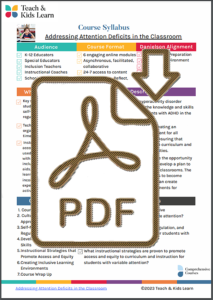Supporting Students with Autism in the General Ed Classroom, Grades K-12
Course Description
 |
According to the CDC, about 1 in 36 children have autism spectrum disorder, or ASD. Before teachers can engage students with autism in the classroom, they must first fully understand the challenges and barriers to learning that having autism may cause and understand how to use student strengths to enhance learning.
This comprehensive instructional course provides you with proven methods to assist you in understanding autism spectrum disorder (ASD) and the impact that having autism has on students, their families, the classroom, and the school community. You will explore a variety of factors and attributes that influence learning and student achievement, such as race, gender, personal differences, learning preferences, and unique upbringings. |
You will learn how to help students, no matter where they are on the autism spectrum, be more productive and successful.
This course will teach you practical ways to create a structured, focused environment to reduce stress and anxiety, as well as methods to help your students become more flexible in coping with change and unplanned events. You will also learn methods to help students develop functional social skills, improve classroom behavior, and improve overall academic achievement. Finally, you learn ways to create a positive, affirming environment that supports equitable learning for all students, with and without disabilities.
Essential Questions
- What is an autism spectrum disorder, and how does it impact teaching and learning?
- How can teachers foster the development of communication and social skills in students with ASD?
- How can teachers help students cope with change and regulate their emotions?
- How can teachers collaborate with families to develop academic success for students on the autism spectrum?
Course Modules
|
| Course Syllabus |
|
Comments from Teachers
“I learned many practical strategies to support students with autism; I appreciate how the course emphasized both academic and social-emotional growth.”
“I’ve had a positive experience with TKL, and I appreciate how practical, clear, and immediately applicable the strategies were for supporting diverse learners in my classroom.” “My overall experience with Teach & Kids Learn (TKL) has been very positive. The course content was practical, well-organized, and directly relevant to my work in the classroom. I appreciated how the modules offered a balance of research-based strategies and real-world application, which made it easy to connect the learning to my daily teaching practices. The flexibility of the course structure also made it manageable to complete alongside my professional responsibilities. I found the reflection questions especially valuable—they encouraged me to think critically about my current approaches and identify meaningful areas for growth. Additional Comments: Thank you for providing such a supportive and relevant learning experience. I feel more equipped to meet the diverse needs of my students, especially those with autism, and I look forward to applying what I’ve learned to create an even more inclusive and engaging classroom environment.”
Danielson Teacher Framework Course Alignment


